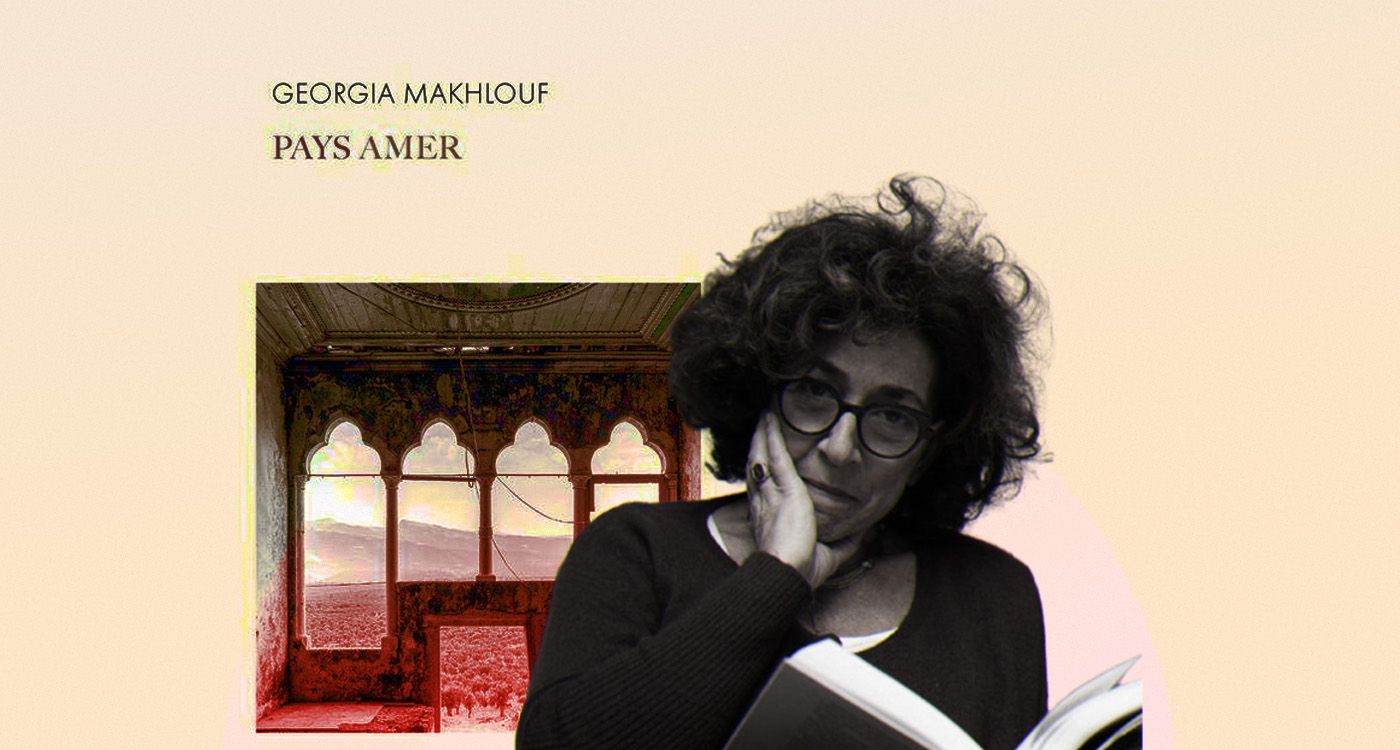
Georgia Makhlouf explores themes of memory and female empowerment in Pays amer (Bitter Land), a novel intertwining the lives of two Lebanese women a century apart. One, inspired by the trailblazing photographer Marie al-Khazen, confronts the societal conventions of the early 20th century, while the other, Mona, searches for an existential meaning in a contemporary Lebanon in crisis.
Pays amer (Presses de la Cité, 2024) is Georgia Makhlouf’s third novel. It weaves together the stories of two Lebanese female photographers, separated by a century. One narrative unfolds in the 1920s, a time when Lebanon is shaping its future, while the other centers on Mona, a woman in 2020, navigating a country in crisis. Oscillating between fiction and reality, the novel draws inspiration from the pioneering Marie al-Khazen, Lebanon’s first female photographer, and explores the echoes between past and present through the lens of female empowerment.
In her signature refined style, Makhlouf crafts a compelling dual portrait of two women where Marie Karam, a character inspired by Marie al-Khazen, is independent and daring, challenging the social conventions of her time by establishing herself as a photographer in French Mandate Lebanon. In contrast, Mona, in modern-day Beirut, captures the city’s painful transformation. When Mona stumbles upon Marie’s hidden diary in a museum archive, it becomes a mirror reflecting her very own quest. By immersing herself in the journey of this trailblazer, Mona seeks to illuminate her own path in a city that has lost its illusions.
“What struck me the most are the similarities, resemblances and echoes between these two women, one century apart; each one experiences, from adolescence, a sense of suffocation within her environment,” reveals Makhlouf in an interview with This is Beirut. “The weight of traditions, behavioral codes, and the strict definitions of gender roles – coupled with the intense pressure to preserve one’s reputation as the most valuable asset – bear down on both women with equal intensity.
Though appearances may suggest change, the walls of the prison remain unyielding.”
Memory and Resistance Through Photography
Photography serves as an act of resistance, a way to reclaim one’s vision and light, challenging oblivion and the dominance of dullness over both the city and its people. “Framing, lighting, composition – each of these is a way to recreate one’s surroundings, to focus on particular aspects and to transform even the most trivial things, things we no longer notice, by giving them new dimensions and meaning,” notes Makhlouf. For Marie, the camera is a weapon that captures fragments of reality and imbuing them with new significance. Her photographs embody a rare freedom for a woman of her time, defying social codes. This rebelliousness inspires Mona who, through her investigation, comes to realize the ongoing resistances that shape her own life.
Makhlouf draws inspiration from Lebanese photographer Marie al-Khazen, whose photographs captured an unexpected modernity within a society constrained by rigid norms. To develop her character of Marie Karam, Makhlouf relied on extensive research and pivotal encounters. “I was fortunate to meet Mohsen Yammine, the first to recognize Marie al-Khazen’s significance and talent, and Yasmine Nachabé Taan, who dedicated a sociological study to her photographs and interviewed her family members. They generously shared invaluable insights, and everything they taught me further fueled my desire to bring this fascinating and uniquely original woman back to life,” she reveals.
Rather than strictly adhering to historical accuracy, Makhlouf’s work takes a novelistic approach, using documentation as the foundation for creative imagination. “Certainly, I carried out historical research on feminist movements in the Middle East from the early 20th century, the evolution of photography in the region, the representation of women and the history of Beirut. However, my aim was never to write a biography or an academic work. My intention was to imagine what this woman’s life might have been, to shed light on the hidden aspects and unravel the enigma of this extraordinary figure,” explains Makhlouf.
For her, writing is an exercise in embodiment, where the author strives to breathe life into the emotions and dilemmas of the characters. “As always in my writing projects, I rely on real and documented facts that allow my imagination to flourish. From there, I endeavor to view the world through my characters’ eyes, embodying their struggles and emotions as closely as possible.”
However, Marie Karam ultimately pays a steep price for her boldness. After staging an exhibition in which women were portrayed dressed as men, her family, unable to contain her free-spirited nature, has her confined to Asfourieh – a psychiatric asylum reserved for those considered too rebellious.
A Lebanon Between Splendor and Decline
Through the dual perspectives of her protagonists, Makhlouf unveils a multifaceted portrait of Lebanon – a land of contradictions, where splendor and ruin, corruption and grandeur, ceaseless change and timeless permanence coexist. Marie Karam’s photographs encapsulate the vibrant energy of a nation in the throes of transformation, showcasing the splendor of its landscapes and the elegance of its cosmopolitan society in the 1920s. In contrast, Mona’s lens captures a harsher reality – one of a country ravaged by repeated crises, wars and waves of migration.
This temporal duality allows the author to subtly explore the sense of bitterness that now defines contemporary Lebanese society, one that remains nostalgic for a time when everything seemed possible. The descriptions of Beirut, shifting from radiant to disfigured, deeply resonate as a metaphor for the gradual decay that haunts the collective memory.
Pays amer goes beyond being a mere personal narrative; it offers a rich historical portrait of Lebanon’s intellectual awakening under French colonial rule. The author depicts a nation in transformation, where the first feminist movements emerge, calling for gender equality. While some progress has been made, deeply entrenched patriarchal structures persist, making the struggle for women’s empowerment an ongoing and pressing one.
Through Mona, Makhlouf depicts the struggles faced by the modern Lebanese woman. As she follows in Marie’s footsteps, Mona embarks on a quest for personal identity in a Beirut marked by unrest, where societal conventions continue to constrain women’s freedoms. This remembrance journey evolves into an act of resistance, though Mona’s perspective is shaped by disenchantment, as she confronts the persistent barriers.
Giving a Voice to Women Who Shaped History
The author emphasizes the importance of reviving the stories of overlooked figures. “There are women who have shaped history, yet remain unacknowledged. By giving them a voice, we break this silence.”
In this light, Makhlouf envisions an encounter between Marie Karam and poetess May Ziadé. Although fictional, this encounter is based on historical facts as both women were confined to the Asfourieh asylum. After the death of her parents and the loss of Gibran Khalil Gibran (Lebanese-American writer, poet and philosopher), with whom she shared a twenty-year epistolary relationship, May Ziadé returns to Lebanon, seeking solace. Her cousin seizes the opportunity to strip her of her inheritance, and has her institutionalized, marking yet another tragic chapter in the history of women silenced by society.
In addition to the photographic legacy, the novel explores women’s ability to speak out through art. “Yes, indeed, I believe that artistic creation offers women a realm of expanded freedom that doesn’t exist in society. Art is this borderless space that offers each individual the freedom to find their own territory and shape a singular and unique way of living and perceiving the world,” asserts the author.
Makhlouf’s writing, both precise and poetic, beautifully elevates the exploration of legacy and the search for meaning.
Pays amer is more than just a historical novel or a tale of individual destinies; it is a feminist work that, without being didactic, interrogates women’s role in society while celebrating the transformative power of art as a means of empowerment. Through this captivating novel, Makhlouf delivers a compelling text that stands as an essential meditation on freedom and memory.





Comments